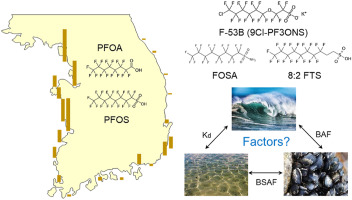当前位置:
X-MOL 学术
›
Chemosphere
›
论文详情
Our official English website, www.x-mol.net, welcomes your
feedback! (Note: you will need to create a separate account there.)
Legacy and emerging per- and polyfluoroalkyl substances (PFASs) in the coastal environment of Korea: Occurrence, spatial distribution, and bioaccumulation potential.
Chemosphere ( IF 8.1 ) Pub Date : 2020-04-01 , DOI: 10.1016/j.chemosphere.2020.126633 Jae-Won Lee 1 , Hyun-Kyung Lee 1 , Jae-Eun Lim 1 , Hyo-Bang Moon 1
Chemosphere ( IF 8.1 ) Pub Date : 2020-04-01 , DOI: 10.1016/j.chemosphere.2020.126633 Jae-Won Lee 1 , Hyun-Kyung Lee 1 , Jae-Eun Lim 1 , Hyo-Bang Moon 1
Affiliation

|
Contamination by per- and polyfluoroalkyl substances (PFASs) is of great concern in global environments. Due to strong regulation of legacy PFASs, emerging PFASs including alternatives and precursors have been introduced to the industrial market. In this study, legacy and emerging PFASs were measured in seawater, sediment, and bivalves collected along the Korean coast to investigate the occurrence, distribution, contamination sources, and bioaccumulation potential of PFASs. Wide concentration ranges of legacy PFASs were detected in multiple environmental samples, indicating widespread contamination. C8-based PFASs (e.g., PFOA and PFOS) were still major contaminants in all of the environmental samples. Some precursors, such as 8:2 fluorotelomer sulfonate (8:2 FTS) and N-ethyl-perfluorooctane sulfonamidoacetic acid (N-EtFOSAA), and perfluoro-2-propoxypropanoic potassium 9-chlorohexadecafluoro-3-oxanonane-1-sulfonate (F-53B), an alternative to PFOS, were detected in sediment or bivalve samples, implying a shift in consumption patterns from legacy to emerging PFASs. The highest concentrations of PFASs in environmental samples were found at the locations near industrial complexes, such as those for the semi-conductor, paper mill, automobile, and metal-plating industry. This result indicates that PFAS contamination is associated with intensive industrial activities in the coastal environment. Matrix-dependent contamination and profiles of PFASs were observed. Seawater was dominated by short-chained PFASs as a prompt reflection of regulation, while the sediment and bivalves were dominated by long-chained PFASs. Carbon-chain length was a major factor governing environmental behavior and bioaccumulation of PFASs. This was the first nation-wide survey on legacy and emerging PFASs in the coastal environment of Korea.
中文翻译:

韩国沿海环境中的遗留和新兴的全氟烷基物质和多氟烷基物质(PFAS):发生,空间分布和生物蓄积潜力。
在全球环境中,全氟烷基物质和多氟烷基物质(PFAS)的污染引起了人们的极大关注。由于对传统PFAS的严格监管,新兴的PFAS(包括替代品和前体)已引入工业市场。在这项研究中,对沿韩国海岸收集的海水,沉积物和双壳类动物中的旧有和正在出现的全氟辛烷磺酸进行了测量,以调查全氟辛烷磺酸的发生,分布,污染源和生物蓄积潜力。在多个环境样品中检测到传统PFAS的浓度范围很广,表明存在广泛的污染。基于C8的PFAS(例如PFOA和PFOS)仍然是所有环境样品中的主要污染物。一些前体,例如8:2含氟调聚物磺酸盐(8:2 FTS)和N-乙基-全氟辛烷磺酰胺基乙酸(N-EtFOSAA),在沉积物或双壳类样品中检测到全氟-2-丙氧基丙酸9-氯十六氟-3-氧杂壬烷-1-磺酸钾(F-53B),这是全氟辛烷磺酸的替代品,这意味着消费模式已从传统的PFAS转向新兴的PFAS。在工业园区附近的地点,例如在半导体,造纸厂,汽车和金属电镀行业,发现了环境样品中PFAS的最高浓度。该结果表明,PFAS污染与沿海环境中的密集工业活动有关。观察到了PFAS的基质依赖性污染和特征。海水以短链PFAS为主,这是对调节的迅速反映,而沉积物和双壳类则以长链PFAS为主。碳链长度是控制PFAS的环境行为和生物积累的主要因素。这是对韩国沿海环境中的传统和新兴PFAS进行的首次全国性调查。
更新日期:2020-04-01
中文翻译:

韩国沿海环境中的遗留和新兴的全氟烷基物质和多氟烷基物质(PFAS):发生,空间分布和生物蓄积潜力。
在全球环境中,全氟烷基物质和多氟烷基物质(PFAS)的污染引起了人们的极大关注。由于对传统PFAS的严格监管,新兴的PFAS(包括替代品和前体)已引入工业市场。在这项研究中,对沿韩国海岸收集的海水,沉积物和双壳类动物中的旧有和正在出现的全氟辛烷磺酸进行了测量,以调查全氟辛烷磺酸的发生,分布,污染源和生物蓄积潜力。在多个环境样品中检测到传统PFAS的浓度范围很广,表明存在广泛的污染。基于C8的PFAS(例如PFOA和PFOS)仍然是所有环境样品中的主要污染物。一些前体,例如8:2含氟调聚物磺酸盐(8:2 FTS)和N-乙基-全氟辛烷磺酰胺基乙酸(N-EtFOSAA),在沉积物或双壳类样品中检测到全氟-2-丙氧基丙酸9-氯十六氟-3-氧杂壬烷-1-磺酸钾(F-53B),这是全氟辛烷磺酸的替代品,这意味着消费模式已从传统的PFAS转向新兴的PFAS。在工业园区附近的地点,例如在半导体,造纸厂,汽车和金属电镀行业,发现了环境样品中PFAS的最高浓度。该结果表明,PFAS污染与沿海环境中的密集工业活动有关。观察到了PFAS的基质依赖性污染和特征。海水以短链PFAS为主,这是对调节的迅速反映,而沉积物和双壳类则以长链PFAS为主。碳链长度是控制PFAS的环境行为和生物积累的主要因素。这是对韩国沿海环境中的传统和新兴PFAS进行的首次全国性调查。











































 京公网安备 11010802027423号
京公网安备 11010802027423号